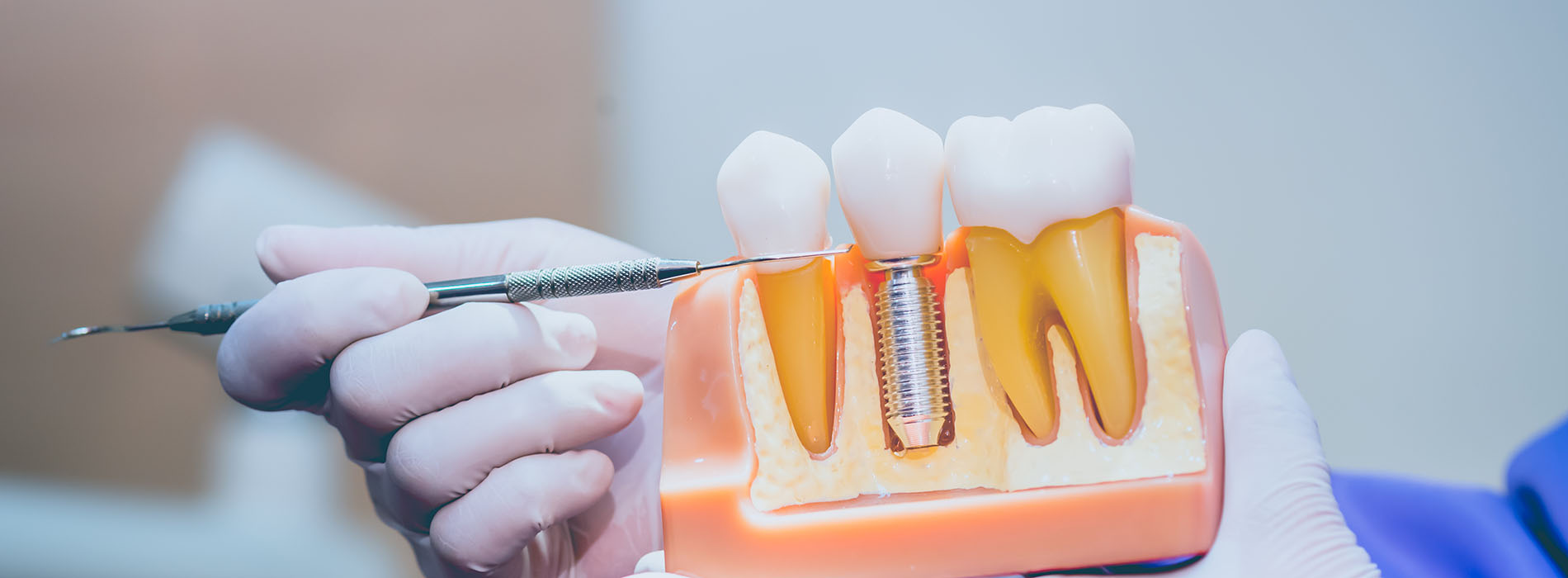Call Us Today!
(248) 863-9109
New Patients
(248) 221-2314

Missing teeth affect more than just appearance — they change how you chew, speak, and how neighboring teeth bear force. Implant restorations replace the lost tooth structure in a way that mimics natural anatomy. By anchoring a prosthetic tooth directly to an implant that integrates with the jaw, patients regain function and feel that are much closer to a natural tooth than traditional removable options.
Beyond function, implant restorations protect oral health. When a tooth is missing, the adjacent teeth and underlying bone can shift or resorb over time, creating bite and alignment problems. Restoring the site with an implant-supported crown or bridge helps preserve bone and maintain the relationships between teeth, which supports long-term stability for your smile.
For patients in West Bloomfield, MI, and nearby communities, implant restorations are often the preferred restorative path when conditions allow. At Royal Dental Center, we emphasize solutions that balance durability, comfort, and aesthetics so patients can enjoy everyday activities like eating and speaking with confidence.
The implant restoration journey begins with a careful evaluation. We assess the health of your gums, the quality and quantity of jawbone, and the condition of neighboring teeth. Diagnostic imaging helps the team plan the optimal implant position to support a natural-looking prosthesis. This upfront planning reduces surprises and helps set realistic expectations for healing and outcomes.
Next comes the surgical placement of the implant post into the jawbone. This is typically performed under local anesthesia with attention to patient comfort and safety. After placement, the implant requires time to integrate with the bone — a biological process called osseointegration. The duration varies by individual but is an important step to ensure a stable foundation for the final restoration.
Once integration is complete and the site is healthy, we take impressions and craft a custom crown, bridge, or implant-supported denture designed to match your bite, shade, and smile shape. The result is a prosthesis that not only restores function but also blends with your natural teeth for an attractive, seamless appearance.
Implant restorations are not one-size-fits-all; the ideal design depends on how many teeth are missing, the condition of surrounding structures, and the patient’s functional needs. For a single tooth, an implant-retained crown provides a discreet and strong replacement. When multiple adjacent teeth are missing, implant-supported bridges recreate a natural contour without relying on neighboring teeth for support.
For patients who have lost many or all teeth, implant-supported overdentures and full-arch bridges offer remarkable improvements in stability and chewing efficiency compared with traditional removable dentures. These restorations can be fixed or removable depending on the goals for maintenance access and comfort. The prosthetic design is chosen to optimize speech, chewing, and long-term oral health.
Material selection and prosthetic design also matter. We work with ceramics and advanced composite materials to achieve lifelike color and translucency while maintaining strength. The laboratory-fabricated restorations are matched to each patient’s unique tooth anatomy, ensuring the final result looks natural under varied lighting and during close conversation.
Caring for implant restorations is straightforward but important. Daily oral hygiene practices — brushing twice a day with a soft-bristled brush and flossing around the implant crown — remove plaque and reduce the risk of soft-tissue inflammation. Special floss, interdental brushes, or water irrigators can be recommended for cleaning under bridges or around implant-supported overdentures to reach areas that are harder to access.
Regular professional follow-up is essential to track the health of the implant and surrounding gum tissue. During routine visits, we examine the integrity of the restoration, assess occlusion (how your teeth meet), and take radiographs when appropriate. Early detection of issues like bone loss or loosening components allows timely intervention, which helps protect the longevity of the restoration.
While implant restorations are designed for durability, they rely on the health of surrounding tissues and careful maintenance. With consistent home care and scheduled professional checkups, many patients enjoy implant-supported teeth for decades, maintaining both function and confidence.
Not every patient will follow the exact same timeline or need the same preparatory treatments. Some patients benefit from bone grafting or soft-tissue augmentation to create a stable, aesthetic foundation before implant placement. Tobacco use, certain medical conditions, and uncontrolled periodontal disease can influence candidacy and are addressed during the planning phase to reduce risks and improve success rates.
Our team emphasizes shared decision-making. We review imaging and explain the options available, including expected healing stages and what to anticipate during each phase of care. This collaborative approach helps patients make informed choices that align with their priorities for appearance, function, and long-term outcomes.
Clear planning also includes contingency strategies: if additional treatments are necessary, we outline the timeline and the reasons they improve predictability. Preparing the mouth for implant restorations is as much about optimizing biology as it is about aligning expectations — both of which contribute to reliable, lasting results.
Wrap-up: Implant restorations are a dependable way to restore form and function after tooth loss, combining advanced surgical techniques with customized prosthetic design. If you’d like to learn how implant restorations could work for your smile, contact Royal Dental Center for more information and to discuss next steps with our team.
Implant restorations are the prosthetic components that replace visible tooth structure and attach to a dental implant. The implant itself is a titanium or zirconia post placed into the jawbone, while the restoration is the crown, bridge, or denture that restores function and appearance.
Unlike removable dentures that sit on the gums, implant restorations are supported by osseointegrated implants and behave more like natural teeth for chewing and speech. This combination of implant and restoration preserves adjacent teeth and helps maintain jawbone volume over time.
A good candidate typically has overall oral health that supports implant placement, including healthy gum tissue and sufficient jawbone density or the willingness to undergo preparatory grafting. Medical factors such as uncontrolled diabetes, heavy tobacco use, or certain medications can affect candidacy and are evaluated during treatment planning.
We tailor recommendations to each patient by reviewing medical history, clinical findings, and imaging to determine whether implant restorations are the most predictable option. For patients in West Bloomfield, MI, and nearby communities, this careful assessment helps identify the safest and most durable restorative pathway.
The process begins with a comprehensive evaluation that includes clinical examination and diagnostic imaging to map bone, nerves, and adjacent teeth. Implant placement is followed by a healing period during which the implant integrates with the bone, a process called osseointegration that establishes a stable foundation for the restoration.
After integration, impressions or digital scans are taken to fabricate a custom crown, bridge, or denture that matches the patient's bite, shade, and anatomy. Final adjustments are made at delivery to ensure comfort, proper occlusion, and a natural appearance.
Common options include single implant crowns for isolated tooth loss, implant-supported bridges for several adjacent missing teeth, and implant-retained overdentures or fixed full-arch prostheses for extensive tooth loss. The choice depends on the number and location of missing teeth, bone quality, esthetic goals, and the patient's preferences about maintenance and removability.
Clinical factors such as opposing dentition, lip support, and occlusal forces also influence design decisions and material selection. A personalized treatment plan balances function, longevity, and appearance to achieve predictable outcomes.
Implant restorations are commonly fabricated from high-strength ceramics like zirconia or layered lithium disilicate, as well as titanium-acrylic or composite options for certain overdentures. These materials are chosen for their strength, wear characteristics, and ability to mimic natural tooth color and translucency.
Material selection affects aesthetics, durability, and how the restoration interacts with opposing teeth. We consult with dental laboratories and consider each patient's functional demands and esthetic needs when recommending a restorative material.
The timeline varies by case but generally includes an initial consultation, surgical placement of the implant, a healing period for osseointegration, and a prosthetic phase for restoration fabrication and delivery. Healing can range from a few weeks to several months depending on bone quality, whether grafting was required, and individual healing dynamics.
Advanced planning and modern protocols can sometimes shorten certain phases, but prioritizing biologic stability leads to more predictable long-term results. Your dental team will outline an individualized schedule and milestones so you know what to expect at each stage.
Daily oral hygiene is essential: brush twice a day with a soft-bristled brush and clean around the implant restoration using floss, interdental brushes, or a water irrigator as recommended. Removing plaque and preventing soft-tissue inflammation helps protect the supporting bone and prolong the life of the restoration.
Patients should also avoid using implants as tools or chewing excessively hard objects and should report any persistent sensitivity, mobility, or swelling to their provider promptly. Consistent home care combined with routine professional maintenance creates the best conditions for long-term success.
Regular dental visits are needed to monitor soft tissues, assess occlusion, and take periodic radiographs to evaluate bone levels around the implant. During these appointments the clinician will check prosthetic components for wear, fit, or loosening and provide targeted cleaning where necessary.
Early detection of problems such as peri-implant mucositis or component wear allows timely intervention that can prevent more serious complications. A schedule of maintenance visits is established based on each patient's risk factors and clinical findings.
While implant restorations have high success rates, potential complications include peri-implant inflammation, mechanical wear or loosening of prosthetic components, and, less commonly, implant failure due to inadequate integration. Risk factors such as poor oral hygiene, uncontrolled periodontal disease, and systemic health issues can increase the likelihood of problems.
Thorough planning, proper surgical technique, appropriate prosthetic design, and routine maintenance reduce these risks significantly. Patients are counseled about warning signs and preventive strategies so that issues can be addressed quickly if they arise.
Look for a provider who presents a clear, evidence-based treatment plan and who collaborates with experienced dental laboratories and specialists when needed. During the consultation expect a review of medical history, a clinical exam, diagnostic imaging, and a discussion of restorative options, timeline, and any preparatory procedures such as bone grafting.
The team at Royal Dental Center emphasizes shared decision-making and transparent planning to align treatment with each patient's goals for comfort, function, and esthetics. A thorough consultation sets realistic expectations and establishes the steps needed to achieve a predictable restoration.
Take the first step toward exceptional dental care! Schedule your appointment with Royal Dental Center today and experience personalized treatment, advanced technology, and a caring team dedicated to your comfort and oral health. Don’t wait—your best smile starts now.
